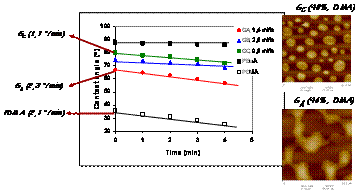Special lectures
1 2
3 4
5 6
7 8
9 10
11 12
13 14
15 16
17
TAILORING mESOPOROUS
pOLYMERIC mATERIALS
FROM sEMI-IPNs AS nANOSTRUCTURED
pRECURSORS
D.
Grande
Equipe
« Systèmes
Polymères Complexes
», Institut de Chimie
et des Matériaux
Paris-Est, UMR 7182 CNRS - Université
Paris XII, 2 rue
Henri Dunant,
94320 Thiais, France
(grande
/ glvt-cnrs.fr)
The
utilization of (semi-) Interpenetrating Polymer Networks (IPNs) as nanostructured
precursors to porous cross-linked materials has been put forward only
by a handful number of research teams.
IPNs constitute an intimate
combination of two
independently cross-linked polymers, at least one of which is
synthesized in the immediate presence of the other.
Such complex polymer structures are of particular interest
when they
arise from the association of two components that exhibit a contrasted
degradability under specific conditions: indeed, (nano)porous
networks can be designed from such IPNs
by
resorting to selective degradation methods.
In this regard, IPNs
based on a hydrolyzable
polyester, such as poly(D,L-lactide)
(PLA) or poly(e-caprolactone)
(PCL), and a polymer containing a
non-hydrolyzable
skeleton, such as
poly(methyl methacrylate)
(PMMA), can be
considered as appropriate precursors.
This
contribution discusses the scope and limitations of two complementary
routes to mesoporous
networks from
polyester/PMMA-based semi-IPN and IPN systems.
In a first stage, the latter precursory networks have been
synthesized by in
situ methods
by varying different structural parameters, including the cross-linker
nature and cross-link density associated with the PMMA sub-network, as
well as the nature and molar mass of the oligoester
precursor. The kinetics
of the cross-linking
processes involved in network formation has been monitored by real-time
infrared spectroscopy.
The microphase
separation exhibited by the nanostructured
precursors and the average
diameters of polyester microdomains
have
been investigated by Dynamic Mechanical Analysis (DMA) and turbidimetry, respectively.
In a second stage, two straightforward and effective approaches that
afford (meso)porous methacrylic
networks with tunable pore sizes have been envisioned.
The first approach applies the extraction of
un-cross-linked oligoesters
from semi-IPNs,
while the second strategy implies the quantitative hydrolysis of the
polyester sub-network from IPNs. In this lecture, we will
particularly focus our
attention on the investigation of the correlations between the
multi-scale structure of the precursory networks and the morphology of
the resulting porous materials as examined by different techniques,
such as Scanning Electron Microscopy (SEM) and thermoporometry
using Differential Scanning Calorimetry
(DSC).
Acknowledgments.
The
financial support of the National Agency for Research (programme
ANR/PNANO 2005, project POLYNANOCAT "ANR-05-NANO-025") is gratefully
acknowledged.
MICROPOROUS, THERMOSENSITIVE
ORGANIC-INORGANIC
HYBRID HYDROGEL PREPARED BY FREEZING
N.
Kato
Department
of Applied
Chemistry, Faculty of Engineering, Utsunomiya University, 7-1-2 Yoto,
Utsunomiya 321-8585 JAPAN (katon / cc.utsunomiya-u.ac.jp)
A simple and
effective method of microporous gel preparation was developed. By
freezing and subsequent re-hydration, a different variety of
microporous gels could be conveniently prepared. This technique was
suited to widely control the responsive shrinking rates of gels and
solute release rates from gels.
The
microporous properties of organic-inorganic (O-I) hybrid gel could be
also altered by freezing.
Basically,
formation of microporous structure during the freezing process was
determined by nucleation of ice crystals and their growth rates. As the
useful way to control the macropore size and stimuli-responsive rates
of gels, the honeycomb-like structure could be controlled by adjusting
the water content of gels prior to freezing.
It appeared that water content was the key factor to
control the
microporosity and the rates of expelling pore water or solutes. Since
the response time of environmentally responsive gels could be
drastically reduced by decreasing the characteristic diffusion path
length, it is possible to enhance the response rate not simply by
reducing the gel size but also by reducing the strut thickness of the
pore walls. This freezing method could be applied to control the
microporosity of gels of which ingredients were polyacrylamide
derivatives, polysaccharides, nucleic acids, or polypeptides.
As
the poly(N-isopropylacrylamide),
polyNIPA, based O-I networks with
polysiloxane
structures covalently attached to the polyNIPA, gels were crosslinked
by inorganic silsesquioxane-like domains formed by sol-gel process of
[3- (methacryloyloxy) propyl]trimethoxysilane (MPTMOS). After gelation,
pore water froze in the gel, causing the polymer chains to gather and
then condense. The heterogeneous networks could be fixed apparently
with hydrophobic interaction between polymer chains even for the O-I
networks. The effective diffusion coeficients of thermally responsive
shrinking for poly(NIPA/MPTMOS) gel (10-3cm2/s)
increased two orders of magnitude over those gels before freezing (10-5cm2/s).
Furthermore, the cumulative distribution of polyethylene glycols (PEGs)
accessible water in gels was determined using the PEGs of 1-38 nm
hydrodynamic radii. It is also noticed that the mean pore size of
microporous gel was found to decrease after freezing of the gel.
Moreover, micron-sized pores were also formed during the freezing
process. Polymer concentration at the macropore strut probably
increases in a way that leads to decrease the mean radius of nano-sized
pores.
ACHIEVING
HIGHLY ORDERED NANOSCALE
FEATURES AT SURFACES USING SELF-ASSEMBLY OF BLOCK COPOLYMERS
M.A. Morris
Department of
Chemistry, University College Cork and Centre for Adaptive
Nanostructures and Nanodevices,
Trinity
College Dublin, Ireland
The self
assembly of molecular building blocks (or nanoparticles) is thought to
be the only practical and cost-effective means of generating sub-10 nm
features at substrates.
However, long range
periodicity is difficult to achieve with areas of high defect density
and ‘mis-alignment’.
This is an important problem in generating substrates of precise
nanometer dimensioned structures for surface design and in particular
as ideal structures to study large molecule interactions.
In Cork, we
have developed methods to generate nanoporous
and self assembled copolymer systems for application as engineered
substrates. Precise
geometry and alignment of
the nanostructure in a single direction is achieved using engineered
substrates. These
substrates consist of
photo-lithographically topographically defined surfaces consisting of
precise channels and grooves in silicon or silica materials. The grooves can be engineered to
widths around
100 nm and depths from 30 to 1 um.
Typical
substrates are shown in figure 1.
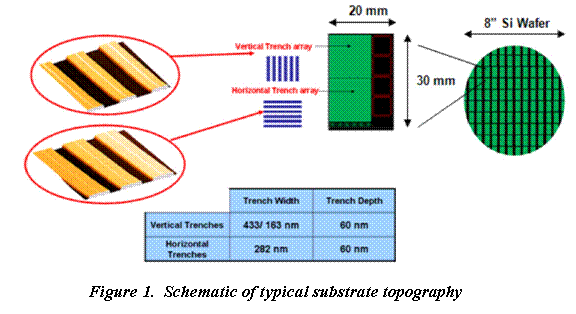
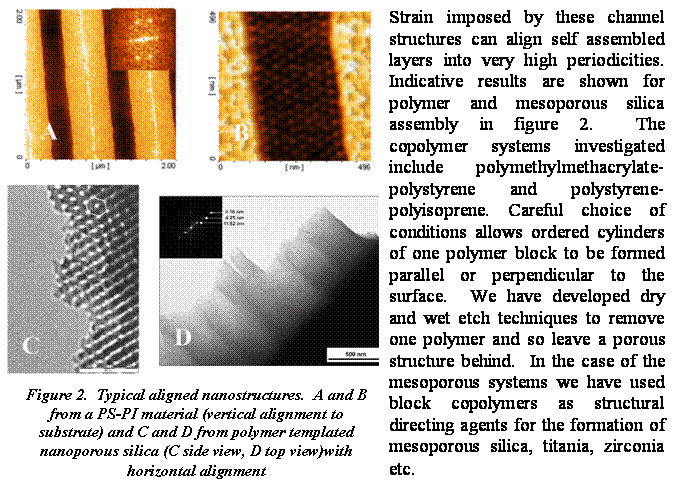
The
inorganic systems have a rigid backbone and we demonstrate how these
can be used to generate a series of ordered nanowire and nanotube
arrays at the surface. The
polymer systems we
have investigated include, polystyrene-polymethylmethacrylate,
polystyrene-polyisoprene
and
polystyrene-polyethylene oxide and these allow the feature size to be
changed from 10 to 30 nm.
We demonstrate how
complex structural motifs equivalent to electronic circuitry might be
achieved using suitable polymers and surface engineering. We present the argument that these
copolymer
systems are the only materials that meet the demands of the electronics
industry. We also present
some results which
demonstrate how the systems
can be chemically
functionalized to allow materials to be placed on the substrate surface
mimicking the exact alignment within the polymer.
These methods allow the fabrication of substrates of engineered
structure and chemical activity.
POSS
grafting on PPgMA by
one-step reactive
blending
A. Fina, D.
Tabuani, G. Camino
Centro di
Cultura per l'Ingegneria delle Materie Plastiche - Politecnico di
Torino, V.le T. Michel, 5
- 15100 Alessandria
(alberto.fina /
polial.polito.it,
http://www.cdcmp.it)
The preparation
of PPgMA/POSS hybrids by direct POSS grafting during a one-step
reactive blending process was successfully explored, taking advantage
of the amino-anhydride reaction in the molten state.
The morphology
of the obtained hybrid material was studied in details by means of
electron microscopy (SEM, TEM) as well as by X-ray diffraction, showing
POSS dispersion at the nanoscale, whereas the corresponding
non-reactive PPgMA/POSS system presented residual micron-sized
aggregates when processed in the same conditions.
The grafting
yield, assessed through extraction of non-grafted POSS and FTIR, showed
a high efficiency of the reactive blending process.
Thermal,
rheological and mechanical properties were studied for POSS-grafted
PPgMA and showed advantages in terms of higher thermal stability and
improved mechanical properties with respect to the non-reactive
PPgMA/POSS system. POSS grafting on PPgMA chains was shown to radically
affect the molecular mobility, resulting in a higher melt viscosity
and, more interestingly, in a significant stiffness and strength
increase.
The effect of
grafted POSS on molecular mobility was explained by POSS/POSS
interactions, which may lead to the formation of nanoclusters that
behave as physical crosslinking points for the flow of PPgMA chains
under deformation.
Thanks to POSS
versatility, it is proposed that grafting POSS moieties on the polymer
backbone by reactive blending can be applied in a number of different
systems, representing a very appealing, economic and efficient way to
improve polymer properties or to obtain new functionalities.
AMPHIPHILIC
GRADIENT COPOLYMERS
SHAPE COMPOSITION INFLUENCE ON THE SURFACE/BULK PROPERTIES
K. Karaky, L.
Billon
Institut
Pluridisciplinaire de Recherche sur l'Environnement et les Matériaux
Equipe de Physico-Chimie des Polymères,
IPREM / EPCP
CNRS UMR 5254
Hélioparc
Pau-Pyrénées, 2 Avenue Angot, 64053 Pau Cedex 09, France
The objective of
this work consists on
the syntheses of gradient copolymers poly(DMA-grad-BuA)
by coupling a hydrophilic monomer (DMA) with another hydrophobic one
(BuA) having a low glass transition temperature (Tg).
We
report here for the first time the synthesis of gradient copolymers by
Semi-Batch Nitroxide-Mediated Controlled Radical Polymerization using a
alkoxyamine (MAMA) as initiator and a excess of SG1 as control agent 1.
We will show the ability of SG1 combined with the MAMA in a process in
Semi-Batch Nitroxide-Mediated Polymerization to control the
copolymerization of DMA with BuA. These copolymers are obtained by
continuous addition of DMA during the polymerization reaction of BuA 2,3.
The
pseudo-instantaneous composition is
used to characterize the gradient copolymers. The variation of the
addition rate of DMA influences on the incorporation of DMA in the
macromolecular chains. The
preliminary surface characterization by the measure of the static water
contact angle of the gradient copolymers films indicates the monomer
unit sequence in the polymer chain strongly influence the surface
organization and properties.
Figure 1.
Relationship between the water uptake kinetic and the structured
gradient copolymer film.
The rheological
properties of gradient copolymers in bulk are also studied
and discussed in
relation with their local
structure. Moreover,
thanks to
the combination of DMA (hydrophilic monomer) /BuA (monomer having a low
Tg)
and to the formation of
phase segregation observed by AFM, these systems can be used for
adhesion in wet media.
1 -
K. Karaky et al., Macromolecules, 40, 458,
2007.
2 -
K. Karaky et al., Soft Matter, 2,
770,
2006.
3
- K. Karaky et al., New Journal of
Chemistry,
30, 698
,
2006.
SYNTHESIS,
MOLECULAR AND
MORPHOLOGICAL CHARACTERIZATION OF SECOND-GENERATION DENDRITIC
HOMOPOLYMERS AND COPOLYMERS OF BUTADIENE AND ISOPRENE WITH DIFFERENT
MICROSTRUCTURES
A. Avgeropoulos*,a,b,
S. Rangoua, V. Krikorianb,
E.L. Thomasa
aDepartment of Materials
Science &
Engineering, University of Ioannina, University Campus, 45110 Ioannina,
Greece
bDepartment of Materials
Science &
Engineering, and Institute of Soldier Nanotechnologies Massachusetts
Institute of Technology, 77 Mass. Ave., 02139 Cambridge, MA, USA
We report the
synthesis of 2nd generation dendritic
homopolymers and
copolymers (Scheme 1A and 1B) consisting of polybutadiene (PB) of 1,4
microstructure or/and polyisoprene (PI) enriched in 3,4 microstructure
(at least 55% PI3,4). The main aspect was the
synthesis of
polymers exhibiting high molecular and compositional homogeneity. The
preparation of these materials was achieved via anionic polymerization
techniques in combination with chlorosilane chemistry potentials. The
molecular characterization of the final dendritic materials was
accomplished via Size Exclusion Chromatography (SEC), Membrane and
Vapor Pressure Osmometries (MO and VPO respectively), Dilute Solution
Viscometry and 1H-Nuclear Magnetic Resonance
(NMR)
Spectroscopy, leading
to the
conclusion that they can be considered model polymers. Morphological
studies have been conducted to the copolymer samples exhibiting
microphase separation between the polydiene segments leading to
hexagonally close packed cylinders of the minority phase in the matrix
of the majority (Scheme 1C).
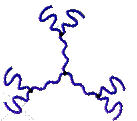
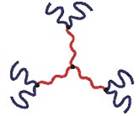
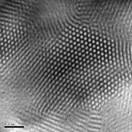

Scheme 1.
A) Schematic of a 2nd
generation dendritic homopolymer, B) of a 2nd
generation
dendritic copolymer and C) hcp cylinders of PI in the PB matrix for a
sample of the [(PB)2PI]3
type.
Structure,
thermal and dielectric
properties of LC thiol with azobenzene mesogenic group and comB-like
polybutadiene-diols modified with thE thiol
M. Ilavskýa,b,
A. Jigounova,
J. Nedbala,
P. Pissisc,
J. Baldrianb,
Z. Sedlákováb
aFaculty of Mathematics
and Physics,
Charles University, V Holešovičkách 2,
1800 Praha
8, Czech Republic
(ilavsky /
kmf.troja.mff.cuni.cz)
bInstitute of
Macromolecular Chemistry, Academy
of Sciences of the
Czech
Republic,
Heyrovského nám. 2,162 06 Praha 6, Czech
Republic
cNationalTechnical
University of Athens, 157 80
Athens, Greece
Liquid-crystalline-5-(4-{[4-(octyloxy)phenyl]azo]}phenoxy)pentane-1-thiol
(TH1) with azobenzene
mesogenic group
exhibiting trans/cis isomerization
was synthesized and polybutadiene
diols (LCPBDs)
with the comb-like architecture were prepared by radical reaction of
TH1 with double bonds of telechelic
HO-terminated polybutadiene
(PBD); DSC,
polarizing microscopy, WAXS and
dielectric behavior of TH1 and LCPBDs
has
been investigated in a broad temperature and frequency regions.
Dielectric spectroscopy of the LCPBDs
has
revealed both, collective and individual dynamic motions of molecules.
Two relaxations, secondary β and segmental α relaxation, were observed
in neat PBD. In the LCPBDs
two secondary γ
and β and two high temperature α and δ relaxations were observed (the
last two not in all the compositions) and assigned to specific
molecular motions. All relaxations were analyzed and discussed in terms
of time scale (Arrhenius
diagram),
magnitude (relaxation strength) and shape of the response.
Characteristic changes of the overall dielectric behavior and of
individual relaxations, as well as of conductivity, studied within the
ac conductivity and the modulus formalisms, were observed at the phase
transition temperatures.
Acknowledgements.
Financial support of
the Grant Agency
the Academy of Sciences of the Czech Republic (grant No. IAA4112401)
and of the Ministry of Education, Youth and Sports of the Czech
Republic (grant MSM 0021620835) is gratefully acknowledged.
STRUCTURAL CHANGES IN
CELLULOSE NANOCOMPOSITES
CHARACTERIZED BY IN-SITU X-RAY DIFFRACTION COUPLED WITH CYCLIC TENSILE
TESTS
J.
Keckesa, P.
Boesckeb, W. Gindlc
aDepartment of Materials Physics, University of
Leoben,
Jahnstrasse 12, A-8700 Leoben, Austria (keckes
/ unileoben.ac.at,
http://www.oeaw.ac.at/esi/)
bEuropean Synchrotron Radiation Facility,
Grenoble, France
cDepartment of Materials Science and Process
Engineering,
University of Natural Resources and Applied Life Sciences, Vienna,
Austria
Cellulosics
represent biodegradable fibrous nanocomposites. In order to understand the
structure-property
relationship in cellulosics, in-situ synchrotron diffraction studies
were combined with tensile tests at the ID01 beamline of the European
synchrotron radiation facility (ESRF) in Grenoble, France. By relating
the mechanical data with the structural information, it was possible to
analyse the deformation processes in the tissues. Upon straining, the
tissues exhibited elastic and plastic behaviour depending on the
original orientation of the crystallites. The deformation beyond the
yield point did not reduce the stiffness of the materials, since the
initial modulus was recovered by every increase and decrease of the
strain. As determined from the diffraction data, the magnitude of the
orientation factors of crystalline cellulose is only the function of
the original texture and the applied strain. The results indicate a
presence of a dominant recovery mechanism occurring between the
interfaces of nanocrystals. The interfaces play a role of slip planes
filled by sacrificial bonds. Whenever the straining is interrupted or
the strain is reduced, the bonds are recovered and the cellulosics show
the original stiffness.
A NOVEL
POTENTIAL
ECOMATERIALBASED
ON POLY(1,4-DIOXANE)-MONTMORILLONITE
NANOCOMPOSITE
Y.-Z. Wanga,b,
K.-K. Yang b,
F.-Y. Huang b, Fang-Lu b,
X.-L. Wangb
a
Ningbo
Institute of Materials
Technology and Engineering, The Chinese Academy of Sciences, Ningbo 31520, China
(polymers
/ 126.com, http://chem.scu.edu.cn/polymer/yzwang/)
b
Center for Degradable and
Flame-Retardant Polymeric
Materials, College of Chemistry, Sichuan Unversity, Chengdu 610064,
China
Poly
(p-dioxanone)
is a useful biomaterial and potential ecomaterial due to its
biodegradability and good mechanical properties. Like other aliphatic
polyesters, however, it has low crystallization rate and low melt
strength, which lead to a difficulty to form thin films by blowing
processing. Those problems have been solved successfully by preparing
poly(p-dioxanone)/montmorillonite
nanocomposites by in situ
ring-opening
polymerization of p-dioxanone
and
montmorillonites in this study. The novel biodegradable nanocomposites
have a remarkably increased crystallization rate and melt strength, and
can be blown to thin films, which have excellent mechanical properties
such as a tensile strength of 59.2MPa and elongation at break of 605%.
Therefore, this novel nanocomposite can be used to prepare some useful
ecomaterials which have a good comprehensive property.
Acknowledgment
This work was supported
financially by the
National Science Foundation of China (20504022) and the National
Science Fund for Distinguished Young Scholars (50525309).
NM-SCALE STRUCTURAL ORIGINS OF
MECHANICAL
PROPERTIES OF POLYURETHANES
C.
PrisacariuaC.P.
Buckleyb,
aInstitute of Macromolecular
Chemistry "Petru
Poni", Aleea Grigore Ghica Voda, nr. 41 A, 700487, Iasi, Romania
(crispris / icmpp.ro).
bDepartment of Engineering
Science, University
of Oxford, Parks Road, OX1 3 PJ,Oxford, UK.
A study has
been made of numerous block copolyurethanes (PUs), based on several
diisocyanates, macrodiols and chain extenders, with the aim of
improving understanding of the relationship between
molecular/supramolecular architecture at the nm-scale and macroscopic
mechanical properties in such systems. A novel diisocyanate
(4,4'-dibenzyl diiscyanate (DBDI)) and a triol chain extender
(1,1,1-trimethylol propane (TMP)) were included as well as more
widely-used components, in order to widen the range of structures
achievable beyond those normally available. A systematic investigation
was made of the effects of varying the chemistry of hard and soft
segment and chain extender, and the preparation procedures employed, on
mechanical response of the PUs. In
polymers with diol chain extenders there were tendencies to phase
separation, with a characteristic length of ca 20nm, and, when DBDI was
employed with certain chain extenders, to crystallization of the hard
phase. In polymers prepared with the triol TMP as chain extender a
crosslinked system was obtained, preventing phase separation.
The role of
the hard segment structure was investigated. When using DBDI,
the specific - Ph-CH2-CH2-Ph-
moiety introduces a
variable geometry into the hard segments due to the possibility of
internal rotation of this isocyanate around the -CH2-CH2-
ethylene bridge. This
leads to the
appearance of both "syn" and "anti" rotational conformations, which
coexist in the DBDI based PU macromolecules.
As a result, in this latter case the PU macromolecules can
adopt a more
compact packing which enhances significantly the ability to order in
crystalline structures involving predominantly the "anti" form. Thus,
new polymers were achieved, with a controlled ordering of copolymer
hard segment blocks on the macromolecular chain.
Wide angle X-ray diffraction and differential scanning
calorimetry
(DSC) of the as-moulded polymers revealed the presence of crystallinity
in the DBDI-based PU materials. Mechanical tests included load-unload
cycles at constant rate of extension, with measurement of hysteresis
and strain recovery, and stress relaxation tests. The presence of the
flexible DBDI hard segments instead of other conventional rigid
isocyanates led systematically to increases in: the input strain energy
to a given elongation, hysteresis and residual strain under cyclic
loading, and stress relaxation. In
large deformation cyclic experiments at room temperature, the degree of
hysteresis and stress relaxation were found to be greatly enhanced by
hard-phase crystallinity, through its effect of increasing the flow
stress. The results from this study provide substantial new insight
into the role played by nm-scale structures in determining the
mechanical properties of PUs.
NETWORK
FORMATION IN PP/LAYERED
SILICATE NANOCOMPOSITES: MODELING AND ANALYSIS OF RHEOLOGICAL PROPERTIES
J. Kovács1,2,
Z. Dominkovics1,2, G. Vörös2,3,
B. Pukánszky1,2
1Laboratory of Plastics and
Rubber
Technology, Department of Physical Chemistry and Materials Science,
Budapest University of Technology and Economics, H-1521 Budapest,
P.O.Box 91, Hungary
2Institute of Materials and
Environmental
Chemistry, Chemical Research Center, Hungarian Academy of Sciences,
H-1525 Budapest, P.O. Box 17, Hungary
3Eötvös University Budapest,
Department of
General Physics, H-1518 Budapest, P.O. Box 32, Hungary
Recently, many
attempts are in progress to modify PP with layered silicates to prepare
nanocomposites. However, such nanocomposites cannot be produced from an
organophilized silicate, mainly montmorillonite (OMMT) and the polymer,
the exfoliation of the clay does not take place spontaneously during
processing, a functionalized polymer, usually maleinated PP (MAPP) must
be added to the composite. The introduction of MAPP leads to
intercalated and/or partially exfoliated structures with improved
properties. Modulus, strength and some other characteristics often have
a maximum as a function of silicate content, which indicates changes in
the structure with composition. Layered silicates easily exfoliate in
water to individual silicate layers. At large clay content the layers
interact with each other in the slurry. Face to face interactions lead
to aggregation, while edge to face interactions result in the formation
of a network, often referred to as house-of-cards or skeleton
structure. Both interactions are claimed to occur also in PP/layered
silicate composites. Aggregation obviously deteriorates properties.
Relatively little is known about the formation of the network structure
and its effect. The exact conditions for network formation are not
known either, they must depend on the properties of the components,
composition, processing conditions, which all influence the extent of
exfoliation and the number of particles dispersed in the matrix.
Usually the network is detected either by transmission electron
microscopy (TEM) or rheology, or both. The TEM micrographs presented in
papers on house-of-cards structures are not very convincing and do not
differ much from other pictures taken from PP/layered silicate
nanocomposites not having such a morphology.
The formation
of the network considerably modifies the rheological properties of
nanocomposite melts; usually a yield stress appears at low shear rates.
This can be detected on the frequency or shear rate dependence of
complex viscosity (h*) or
storage modulus (G') as an upward turn in the low shear region. The
method is less subjective than TEM, but the changes in the shape of
viscoelastic functions might render detection difficult. We used
various approaches to analyze the rheological properties of PP/layered
silicate nanocomposites. Cole-Cole
plots proved to
be useful, since they detect the network very sensitively. The
frequency dependence of the real part of complex viscosity was
described with a series of Maxwel bodies coupled parallel to each
other. The relaxation time of the melt changes in the range of 0.0005
and 200 sec. Under certain conditions long relaxation times appear in
the spectrum, which indicate the formation of new structural units,
probably the silicate network. A certain number of silicate layers are
needed to create a house-of-cards structure. A threshold concentration
of MAPP exists in the investigated system, which depends on silicate
content.
INFLUENCE
OF ORGANIC PEROXIDES ON
MORPHOLOGY AND PROPERTIES OF EVA-ORGANOCLAY NANOCOMPOSITES
S.B.
Mishra, A.K. Mishra, A.S. Luyt*
Department
of Chemistry, University of the Free State (Qwaqwa Campus), Private Bag
X13, Phuthaditjhaba, 9880, SOUTH AFRICA
Nanocomposites were prepared using an
ethylene vinyl acetate copolymer (EVA) and organically modified clay
(Cloisite® 93 A) in the absence and presence of
dicumyl
peroxide (DCP) and dibenzyl peroxide (DBP) as cross-linking agents. The
results clearly show differences in the EVA-clay morphology of
nanocomposites prepared in the absence of organic peroxides, and of
those prepared in the presence of respectively DCP and DBP. It seems as
if DCP may initiate grafting between the polymer and the clay, which
results in a complete exfoliated morphology. The presence of clay,
however, seems to inhibit the initiation of crosslinking by the DBP
free radicals. This leads to hydroxylated edge-edge interaction between
the clay layers, which gives rise to a flocculated morphology and
reduced polymer-clay interaction. There is a good correlation between
these morphologies and the thermal stabilities of the nanocomposites,
as studied through TGA, the total crystallinity, as seen from the DSC
melting and crystallization enthalpies, and the tensile properties.
* E-mail:
luytas / qwa.uovs.ac.za
Melt
processing-Property
Relationships in multiwalled carbon nanotube-polymer composites
P. Pötschkea,
S. Pegela, T. Villmowa,
I. Aligb, S.
Dudkinb, D. Lellingerb
a
Leibniz
Institute of Polymer Research
Dresden, Hohe Str. 6, 01069 Dresden, Germany (poe / ipfdd.de)
bDeutsches Kunststoff-Institut
Darmstadt,
Schlossgartenstraße 6, 64289 Darmstadt, Germany
In context with
industrial application of carbon nanotube-polymer composites melt
processing is the preferred preparation and shaping method. Melt
processing conditions play an important role on the formation of the
nanotube network required for electrical conductivity or antistatic
discharge behaviour.
In many
basic investigations, compounded nanocomposite materials are
compression molded to sheets, films, or plates in order to get
information about conductivity or mechanical properties. It could be
shown for PC-MWNT composites that pressing conditions play an important
role on conductivity of the samples. This is related mainly to
differences in the nanotube network arrangement which changes with
pressing temperature, velocity, time, cooling conditions, and sample
shape (thickness). In partially crystalline polymers, i.e. polyamides,
in addition the crystallization structures in the presence of the
nanotubes and the crystallization conditions may influence the
composite conductivity.
Similar effects
can be observed in injection molding. The electrical conductivity of
samples strongly depends on the processing conditions, but also varies
on different locations within the sample. This again is related to
differences in the network arrangement of the nanotubes (aggregation,
alignment, orientation) within the sample; in addition a depletion of
nanotubes at surfaces may not be excluded. Systematic variation in
selected injection molding conditions in polycarbonate composites
containing 2 and 5 wt% MWNT indicated differences up to 5 decades in
electrical surface conductivity of injection molded plates with a fixed
sample geometry. The main influencing parameters could be extracted and
will be presented.
ALTERNATIVE SYNTHETIC ROUTES
TO EPOXY
POLYMER-CLAY NANOCOMPOSITES VIA MINIMIZATION OF THE ORGANIC MODIFIER
CONTENT IN ORGANOCLAYS
K.S.
Triantafyllidisa,*,
P.I. Xidasa, T.J. Pinnavaiab
aDepartment of Chemistry,
Aristotle
University of Thessaloniki and CPERI/CERTH, 54124 Thessaloniki, Greece (ktrianta / chem.auth.gr,
http://www.chem.auth.gr)
bDepartment of Chemistry,
Michigan State
University, East Lansing, Michigan 48824, USA (pinnavai
/ cem.msu.edu,
http://www.chemistry.msu.edu/)
Polymer -
layered silicate nanocomposites (PLSN) usually exhibit improved
physical and performance properties in comparison to pristine polymers
and conventional composites, due mainly to their unique phase
morphology and the interfacial properties provided by the highly
dispersed silicate nanolayers in the polymer matrix. Loadings of only
~5 wt. % exfoliated silicate nanoparticles in PLSN materials result in
significant enhancement in mechanical and barrier properties, thermal
stability, resistance to solvent swelling and flammability and ablation
performance. However,
the
reinforcement of the polymer matrix is compromised by the presence of
the organic modifiers of clays due to the introduction of dangling
chains that reduces the degree of polymer crosslinking and weakens
interfacial adhesion. In addition, utilization of large quantities of
modifiers, which are usually quaternary
ammonium ion surfactants, induces economical and environmental issues
in the manufacture and the after-use disposal of nanocomposites.
Our approach is based on the utilization of
homostructured mixed organic / inorganic cation exchanged smectite
clays (e.g., montmorillonite, fluorohectorite) in which both the organic onium ions
and the inorganic
exchange ions co-occupy the gallery surfaces of the clay, thereby
dramatically reducing the amount of organic modifier needed to access
the galleries for nanocomposite formation. By the use of long-chain,
aliphatic polyoxypropylene diamines (Jeffamines), which can also
function as epoxy polymer curing agents, reduction of modifier down to
~35% onium ion exchange can be achieved still
leading to highly intercalated / exfoliated nanocomposite structures
with enhanced thermomechanical properties. Further improvement has been
attempted by the use of triamines in order to benefit both from their
large volume/size for efficient clay platelets separation with minimum
amount of modifier and from the functionality of the free amino-groups
of the triamine which have not been bound to the clay surface.
Structure characterization data on the degree of clay layer exfoliation
(XRD, TEM), mechanical properties (stress-strain tests, DMA) and
thermal stability (TGA) will be reported for the new epoxy
nanocomposites in comparison to those of the pristine polymer.
PMMA-EPOXY-CLAY
TERNARY BLENDS:
SYNTHESIS AND PROPERTIES
M. Hernandeza, B. Sixoub,
J. Dupuya,
J. Ducheta, H. Sautereaua.
a
Laboratoire
des Matériaux
Macromoléculaires, UMR IMP CNRS #5223, Institut National des Sciences
Appliquées-Bât. Jules Verne 17, Av. Jean Capelle, 69621Villeurbanne
Cedex, France
b
MATEIS/INSA,
Institut National des
Sciences Appliquées-Bât. B. Pascal 7, Av. Jean Capelle, 69621
Villeurbanne Cedex, France
marcelo.hernandez
/ insa-lyon.fr
The present
research reports the preparation, results and analysis of
PMMA-epoxy-clay ternary composite. Studies related to ternary blends
containing layered silicates at the present time are limited1,2,3.
The importance of this study is to get information concerning the
influence of poly (methyl methacrylate) (PMMA), montmorillonite layered
silicates (Cloisite30B) and dispersion mechanism on morphology, curing
kinetic and mechanical properties of a three phase epoxy nanocomposite.
Two processing
techniques have been
used and compared: one employing melt intercalation and the other using
ultrasonic processing. In order to understand the exfoliation
mechanisms in ternary blend the dispersion of plates during the curing
reaction was followed, as well as the influence of the preparation
method on the final morphologies obtained was investigated.
Ternary composites
were characterized by
Wide-angle-X-ray (WAXS), Transmission Electron microscopy (TEM) and
Small angle X-ray scattering (SAXS) where these last studies were developed on
the cured
composites and also during the curing reaction. Organoclay particles
were finely dispersed into thermosetting network and predominantly
delaminated in ultrasonic-blending, whereas organoclays formed
micrometer-sized aggregates in melt-blending. For reacted systems an
exfoliation of platelets can occur through the de-aggregation of large
agglomerates into smaller particles composed of a few platelets. For in-situ
SAXS studies the
distribution of the thicknesses of diffusing entities and the
evolutions of this distribution with reaction time were followed.
The kinetic model
showed that the
presence of clays does change the reaction rate, but it not changes the
conversion at the cloud point, In addition the clay does not have any
effect on the reaction induced phase separation phenomenon. The glass
transition temperature of the system obtained by ultrasonic dispersion
is lower than the sample gotten by met dispersion. Mechanical
properties (DMA and fracture) are presented, and discussed with the
presence and nature of PMMA and the influence of the different
dispersion tools used.
References
(1) Park,
J.H., Jana, S.C. Polymer
2003,
44, 2091
(2) Frolich
J, Thomann R, Mulhaupt R. Macromolecules
,2003,
36, 7205-7211
(3) Ratna D.,
Becker O., Krishnamuthy R., Simon G.P., Varley R.J. Polymer,2003,
44, 7449-7457.
NANOSTRUCTURED POLYMERIC
MOLECULAR SIEVES
A.R. Albunia1,
Ch. Daniel1, C. D'Aniello,1
P. Rizzo1,
V. Venditto1, G. Mensitieri2,
P. Musto3,
G. Guerra1
1Dipartimento di Chimica,
Università di Salerno, via
Ponte don Melillo, 84084
Fisciano (Salerno), Italy. E-mail:guerra / unisa.it 2
Dipartimento di Ingegneria dei Materiali e della Produzione, Università
di Napoli "Federico II". 3 Institute of
Chemistry and
Technology of Polymers, CNR
The improvement
of gas storage, recognition and separation techniques represents a
strategic industrial and environmental objective. Some techniques are
based on gas absorption on high surface amorphous materials, like e.g.
activated carbons, crosslinked polymers or carbon nanotubes. More
selective techniques are based on self-assembling of gas-molecules into
cavities of crystalline materials leading to molecular complex
crystalline phases (generally clathrate phases). The available
nanoporous crystalline frameworks can present a large variety of
chemical structures. Mostly studied are inorganic frameworks (e.g.,
zeolites) and, more recently, metal-organic frameworks and organic
frameworks.
In this
paper we show that the d
crystalline
phase of syndiotactic polystyrene (s-PS), presenting a permanent open
architecture, 1,2 can be considered as a first
case of polymeric framework.
In fact, already at room
temperature, this polymer crystal phase is able to self-assemble
suitable gas-molecules leading to molecular complex crystalline phases.
It is well
known that s-PS is a polymer which forms molecular complex crystalline
phases (both clathrate
and intercalate) with
several, mostly aromatic and/or halogenated, guest molecules. By
suitable solvent extraction procedures, the guest molecules can be
easily removed leading to the nanoporous d
form (monoclinic,
space group P21/a; a
= 1.74 nm; b
= 1.18 nm; c
= 0.77 nm;
g
=117°; density =
0.98 g/cm3)1
with a permanent cavity (of 120-160 Å3) per 4
monomer units
(Figure 1).2 This
low density crystalline
framework rapidly absorbs
volatile organic
molecules, also if present in traces in air or water, eventually
leading to host-guest molecular complex phases and hence is promising
for applications in chemical separations,3
molecular
sensorics,4,5 as well as for advamced optical
materials.6-8
It will be also shown that aerogels including
this nanoporous crystalline phase are also particularly suitable for
water and air purification from volatile organic compounds.3
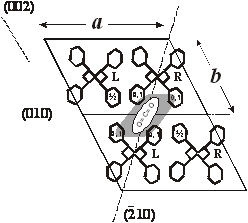
Figure
1 -
Insert here the Figure
and its title bellow in Times New Roman 8)Along c
view of two adjacent unit cells of the host d form of s-PS.
Suitable
crystallization procedures can lead (002), (010) or (`210)
crystal planes nearly parallel the
film surface. Guest release kinetics can be controlled by these
uniplanar crystalline phase orientations.
References
1.
De
Rosa, C., Guerra, G.,
Petraccone, V., Pirozzi, B. Macromolecules
1997, 30,
4147.
2.
Milano,
G., Venditto, V.,
Guerra, G., Cavallo, L., Ciambelli, P., Sannino, D. Chem. Mater. 2001, 13, 1506.
3.
Daniel,
C., Alfano, D.,
Venditto, V., Cardea, S., Reverchon, E., Larobina, D., Mensitieri, G.,
Guerra, G. Adv.
Mater. 2005,
17, 1515.
4.
Mensitieri,
G., Venditto,
V., Guerra, G. Sensors and
Actuators B
2003, 92,
255.
5.
Giordano,
M., Russo, M.,
Cusano, A., Mensitieri, G., Guerra G. Sensors
and
Actuators, B 2005, 109, 177.
6.
Venditto,
V.; Milano, G.; De
Girolamo Del Mauro, A.; Guerra, G.; Mochizuki, J.; Itagaki, H. Macromolecules 2005,
38,
3696.
7.
Stegmaier,
P.; De Girolamo
Del Mauro, A.; Venditto, V.; Guerra,
G. Adv.Mater.
2005, 17, 1166.
8.
Uda,
Y.; Kaneko, F.;
Tanigaki, N.; Kawaguchi, T. Adv.Mater.
2005, 17, 1846.
AN
EFFICIENT SYNTHESIS STRATEGY FOR
HIGHLY NONPLANAR OPTO-ELECTRONIC NANOMATERIALS BY BF3•Eto2-MEDIATED
FRIEDEL-CRAFTS REACTION
Ling-Hai
Xiea,
Bao-Min Zhaob,
Lian-Hui Wangb,
Wei Huanga,*
aInstitute
of
Advanced Materials (IAM), Nanjing
University of Posts and
Telecommunications (NUPT), Nanjing
210003,
China (wei-huang / njupt.edu.cn)
bInstitute
of
Advanced Materials, Fudan
University, Shanghai 200433, China.
Complicated
9,9-diaryfluorenes (CDAF) is a kind of nonplanar
building blocks which can be prepared by BF3•OEt2-mediated
Friedel-Crafts reaction.
A series of nanomaterials
based on CDAF building blocks, TPA-terF,
and Cz-tetraF
with nonplanar multi-dendron
and 3-D persistent architectures was designed and constructed. High
thermal stability and quantum yield indicate that TPA-terF and Cz-tetraF
are potential materials due to unique three-dimensional conformation
for opto-electronic
application. In
addition, the synthetic strategy can help us scale up the synthesis of
pure-blue light-emitting dendrimers
with terfluorene unit.


